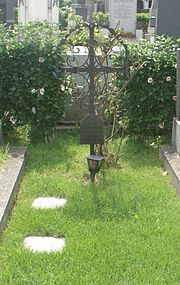Erwin Ratz
Erwin Ratz (born December 22, 1898 in Graz , † December 12, 1973 in Vienna ) was an Austrian music theorist and musicologist.
Life
Ratz studied from 1918 to 1922 with Guido Adler at the Institute for Musicology at the University of Vienna . At the same time, from 1917 to 1920, he attended Arnold Schönberg 's seminar for composition. Schoenberg's group of students included the pianist Olga Novakovic and Hanns Eisler , with whom Ratz was friends. For Ratz, Schönberg was the central personality of his youth. Teaching with him was one of the crucial foundations of Ratz's thinking. In order to present Schönberg's work to a broader public, in 1918 he organized “ten public rehearsals for Schönberg's Chamber Symphony ”, a series of events from which the “Association for Private Musical Performances” emerged in November 1918.
In 1921, financial problems prompted Ratz to take up a position as a secretary at the Bauhaus in Weimar. For »Ratz, this period of intense artistic life was extremely formative. The multitude and richness of impressions and the lifelong artistic attitude at the Bauhaus, which also included an interest in the latest musical developments, were among the decisive impulses in his life. «He returned to Vienna in 1922 or 1923. After the Second World War , Ratz took over one in 1945 Lecturer in formal theory at the Academy for Music and Performing Arts in Vienna and worked as editor for Universal Edition Vienna (piano sonatas and piano variations of Beethoven, piano sonatas by Schubert). In 1957 he received the title of professor. From 1949 to 1968 he was involved (from 1952 in a leading position) in the Austrian section of the International Society of New Music (IGNM).
Ratz achieved international renown as president of the Gustav Mahler Society, founded in 1955 . Among his music-theoretical and musicological works, the publication of Gustav Mahler's complete edition and the introduction to the theory of musical forms deserve special mention. In this, Ratz »starts from the idea of an 'archetype' which, analogous to the 'primordial plant in Goethe's doctrine of metamorphosis', underlies all musical forms. A joint consists of three to Ratz by interludes associated bushings ; the fact that literary examples barely comply does not change anything in this ›idea of the fugue‹. And while Ratz's theory of forms exclusively looks at Bach and Beethoven from a mutual perspective - to prove that Bach's inventions and Beethoven's piano sonatas are based on 'common creative bases' - he ultimately aims to 'find principles that are common to all forms'.
His grave is on the Döblinger Friedhof (Gr. 33, R. 1, No. 30) in Vienna.
Awards
- Silver Medal of Honor of the Federal Capital Vienna (February 26, 1969)
- Righteous Among the Nations (November 25, 2014)
Fonts
- Introduction to the theory of musical forms. On principles of form in JS Bach's inventions and their significance for Beethoven's compositional technique , Vienna 1951. (The first edition was published by Österreichischer Bundesverlag, the second and third, expanded and redesigned edition were published in 1968 and 1973 by Universal Edition Vienna, ISBN 3- 7024-0015-X ).
literature
- Johannes Kretz: Erwin Ratz: Life and Work . Lang, Frankfurt am Main 1996, ISBN 3-631-49520-X
- Clemens Kühn: Form. Theory, analysis, teaching . In: Journal of the Society for Music Theory (= ZGMTH) 2–3 / 2 (2005), Hildesheim 2007, ISBN 978-3-487-13514-4 , pp. 203 f.
- Ulrich Kaiser: Erwin Ratz and the functional theory of forms . musikanalyse.net, 2018
Web links
- Literature by and about Erwin Ratz in the catalog of the German National Library
- Wolfgang G. Vögele: Erwin Ratz.
- Erwin and Lonny Ratz: Righteous Among the Nations. (PDF) Israeli Embassy in Austria
Individual evidence
- ↑ Kretz 1996, p. 37.
- ↑ Kretz 1996, p. 38, fn. 18.
- ↑ Clemens Kühn, 2005. Online: Kühn 2005
- ↑ Lonny and Erwin Ratz - "Righteous Among the Nations". ( Memento of the original from November 4, 2016 in the Internet Archive ) Info: The archive link was inserted automatically and has not yet been checked. Please check the original and archive link according to the instructions and then remove this notice. German Embassy Vienna
| personal data | |
|---|---|
| SURNAME | Ratz, Erwin |
| BRIEF DESCRIPTION | Austrian music theorist and musicologist |
| DATE OF BIRTH | December 22, 1898 |
| PLACE OF BIRTH | Graz , Styria |
| DATE OF DEATH | December 12, 1973 |
| Place of death | Vienna |
